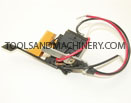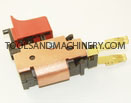There are a surplus of things that can go wrong with your power tools, this is widely known; what is less known, however, is just which thing is wrong at which time. Fortunately though, there are a few tricks to help you know just which component in that intricate parts conglomerate is presently your weakest link. Take your switch for instance, this is a part that may seem nondescript or inconsequential, realistically though, the switch is a vital piece of your power tool’s performance and a variety of spooky things will begin haunting your power tool should its switch be kicking the bucket.
The first symptoms to arise will come in the form of malfunctioning or failing start-ups. You will attempt to activate the tool and as if life has simply left it for greener pastures, the tool will be absolutely dead, or, at least, it will require several pumps and perhaps a joggle or two to revive itself. Overtime, it is regular wear and tear on the switch’s interior connections that causes these, well, incomplete connections and consequently your incomplete start-ups as well. This wear and tear will also effect (in no particular order) the performance of your tool when it does activate. You will likely experience a decrease in the tool’s normative power as little bits of the tool’s juice or energy is lost in transmission. Such malfunctions may also be caused by a switch battling heat damage, therefore, simply relying on the newness of your power tool or the infrequency of its use may not always be the most accurate reference frame.
If these symptoms are left untreated or undetected, the switch will simply short-out completely and start-up (and obviously use as well) will be impossible until the switch is replaced. Although a switch replacement is a reasonably achievable repair process, or at least a relatively inexpensive one, it is always best to settle all disputes with a good-old-fashioned visual inspection. Normally, it can be very clearly seen if your switch has suffered any heat damage – the interior wiring will be discolored, or the wires and connectors may appear burned or melted. If there is no visible heat damage or other untoward appearances, it is likely the switch itself, with all its own wires and gizmos, has simply met (or is very close to meeting) its maker.
Replace the switch, or have it replaced by a technician, and you and your power tool should be back on the high-road in no time. If, however, you still have problems with start-ups or with weak performance, I suggest checking your carbon brushes. If your brushes appear to be in fine working order, there could be a more serious problem. Take the tool to a authorized power tool repair center for a more thorough inspection.
In summary, if you tool has trouble starting, or if you notice a decrease in its regular power or performance, its likely your switch needs to be replaced. Remember though, to always take good care of your power tools and these part replacements will be far fewer and further between.
















